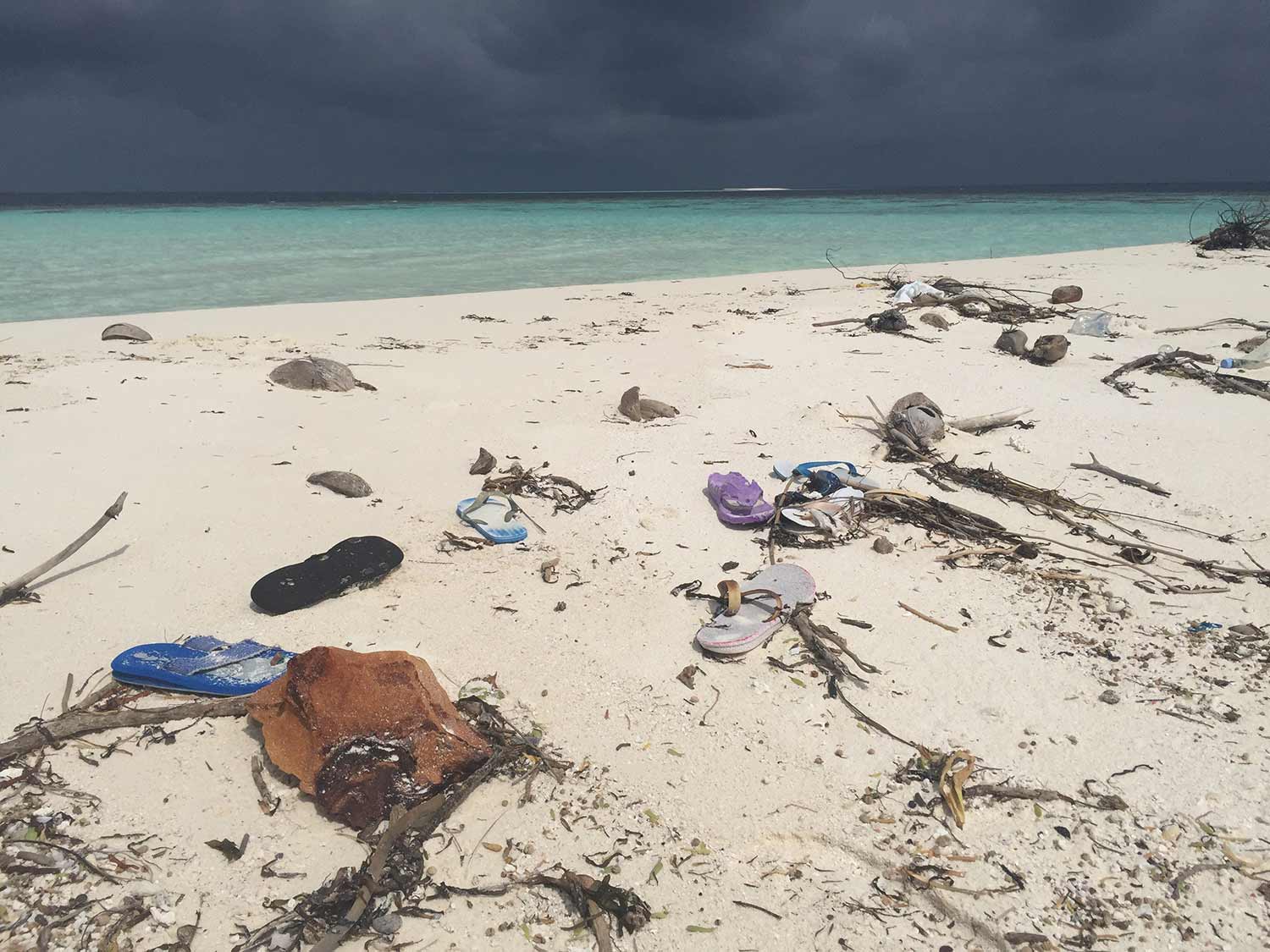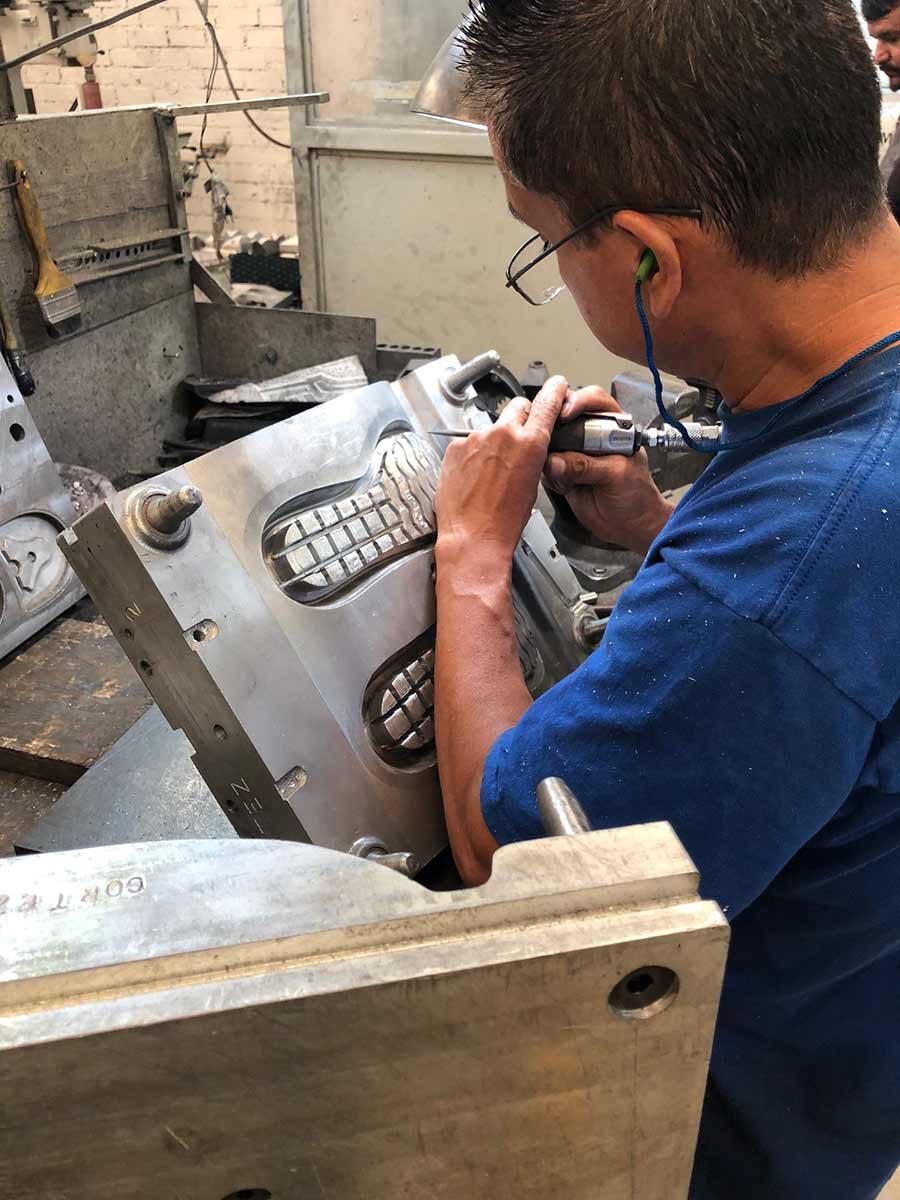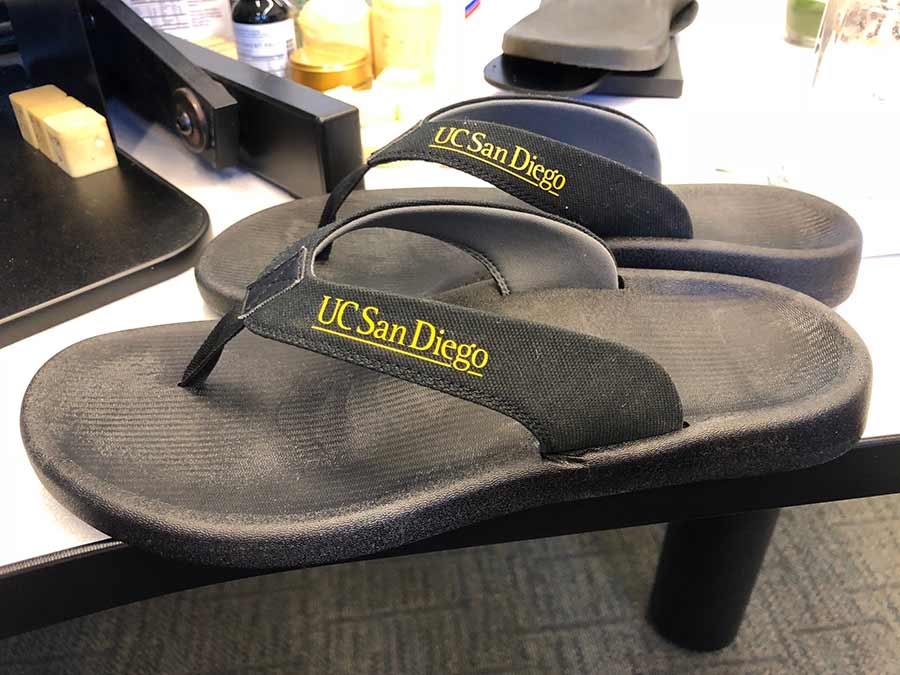By:
- Mario Aguilera
- Cynthia Dillon
Published Date
By:
- Mario Aguilera
- Cynthia Dillon
Share This:

Even a small uninhabited island in the Maldives is marked with human pollution. The flip-flops on this Indian Ocean beach likely came from India or China, more than 1,000 miles away. Photo courtesy of Stephen Mayfield.
UC San Diego Forging a Sustainable Future with Renewable Products
Cutting-edge science and new center for biodegradable goods target environmental scourge of plastic waste
Although they were introduced back in the 1950s, the true dawn of plastics is rooted in the 1970s. Along with disco and bellbottoms, the ’70s ushered in a meteoric rise in everyday consumer plastics. Single-use straws, product packaging, omnipresent water bottles and a range of modern household items went plastic during the decade.
Turn the clock forward to today. Humans have generated more than 6 billion metric tons of plastic waste. This trend is expected to skyrocket. At current rates, over the next 30 years we will see four times more plastic waste than we have to date, and within that time frame, we will dump 13 billion metric tons of virtually indestructible plastic waste into the environment.
Realizing that our oceans will have more plastic than fish by 2050, a team of chemists and biologists at UC San Diego set up a new center for renewable materials on campus. Here, they align theory and practice to produce algae-based, commercial-quality polyurethane materials that give society a fighting chance at knocking out the perils of plastic pollution.
“In many ways, there is no future other than this,” said Biological Sciences Professor Stephen Mayfield. “The actual science behind this is not going to be nearly as tough to pull off as convincing people that this is what we have to do. Changing people’s habits is actually harder than doing the research and development.”
Meet the Center for Renewable Materials
In recent years, UC San Diego has been home to noteworthy proof-of-concept prototype products that demonstrate the possibilities of tangible products made for a sustainable future. Look around the university to see biodegradable flip-flops with Triton logos or sustainable surfboards carving the waves offshore near campus.
In fact, UC San Diego is being positioned to be a world leader in materials science with recent funding of $18 million from the National Science Foundation to open another related center on campus—the Materials Research Science and Engineering Center (MRSEC).
Separate from MRSEC, but affiliated, the Center for Renewable Materials is led by professors of chemistry and biochemistry Michael Burkart and Robert “Skip” Pomeroy, and Mayfield, who are working together to forge a new field of synthetic sustainable materials. With a one-two punch of chemistry and biology, they are leveraging algae and its byproducts to make renewable polymers like polyurethane foams that can be used to create commercial products—goods such as flip-flops, surfboards, fabrics, paints and more. Their approach has huge potential for transforming the way consumer products are developed and the way they decompose, offering relief to landfills, rivers and oceans.

An employee at a manufacturing facility in Leon, Mexico, puts the finishing details on a polyurethane flip-flop mold. Photo courtesy of Stephen Mayfield.
“Working with our commercial partner Algenesis, using commercial-quality, biodegradable foams (made from algal biomass), we made viable shoes and degraded them, characterizing everything that came off of them as they degraded—including the organisms that ate them,” explained Mayfield. “We realized we could use those byproducts to synthesize more polyurethanes to create a ‘bioloop.’”
Their collaborative efforts recently resulted in newly published research on bio-based polyurethanes with 52 percent bio-content that are 100 percent biodegradable. Their next research step is to explore the bioloop further, so they can reach 100 percent renewability within the next five years.
“Polyurethanes are incredibly versatile polymers that can be used in a number of applications, including flexible and rigid foams, adhesives, coatings and resins. Renewable products containing these materials will be sold this year,” said Burkart. “Petroleum-based polyurethanes are also extensively used in structural and insulating components in buildings, and the team is currently developing composite materials that are composed of biodegradable urethane resins, in combination with agricultural waste, to create biodegradable composite structural materials.”
By establishing the center last year, and launching it officially later this month, the team will use it to focus on three major goals: 1) the development of renewable and sustainable monomers made from algae and other biological sources, and their formulation into polymers for diverse applications; 2) the creation of synthetic biology platforms for the production of monomers and crosslinking components and 3) the development and understanding of biodegradation of renewable polymers.
Aligning theory and practice
In order for the Center for Renewable Materials to emerge as a true sustainability change-maker, its leaders know its impact must touch the environment and people’s lives—beyond academic classrooms and labs. Burkart, Mayfield and Pomeroy, therefore, are already taking their materials into the world for use in everyday products. They are collaborating with industrial designers from other universities and with industry partners nationally and in Mexico to understand consumer needs and to learn more about the various ways to apply and manufacture these new sustainable products.
“Public sentiment is coming around and people are demanding a turn toward sustainable products,” said Burkart. “We are lucky to be at the right place at the right time.”
While moving forward to meet consumer and climatic need, the center will maintain a strong focus on the education of students, too.
“There is a consortium of students—alumni, undergrads and graduate students—from engineering, chemistry, chemical engineering, biology—working together,” said Pomeroy. “An important part of this is that we are sharing with them, so they can see the paths to entrepreneurism and working in teams across disciplines.”
In addition to working in labs of the Division of Biological Sciences and the Division of Physical Sciences, the center’s team also involves leaders from across campus, including the Skaggs School of Pharmacy and Pharmaceutical Sciences, Scripps Institution of Oceanography and the Department of Visual Arts. Together, their efforts counter the engineers and scientists who worked during the 1950s and ’60s to purposefully remove biodegradable aspects of the new plastics for maximum durability.

Researchers in the new Center for Renewable Materials have developed consumer-ready flip-flops that can biodegrade in soil and compost. Photo courtesy of Stephen Mayfield.
“That’s the question I sometimes ask,” said Pomeroy. “If you could turn back the clock and re-envision how you would make the petroleum polymer industry, would you do it the same way you did it 60 years ago? There’s a bunch of plastic floating in the Pacific that suggests we shouldn’t have done it that way.”
Mayfield notes that chemists at the time were given a directive to make something cheap that lasted forever and didn’t degrade. “So they did,” he said. “And now, only in retrospect, are people thinking that maybe the life of the material should be proportional to the life of the product. So don’t make a product with material that sits around for 500 years for a product that you’re only going to use for a year or two.”
This is where the trio’s scientific theory and practice factor in.
“I can’t tell you how many times I’ve said, ‘Theoretically, it should work this way,’ only to find out that it worked every way but that way,” admitted Mayfield. “When we put these foams in soil, I remember the first time we pulled them out after a month, we were surprised that they were biodegrading so quickly,” adding that after four months they were completely gone.
“There are not too many times when theory and practice align so well,” he said.
Along with research published in May in Green Chemistry and Organic Process Research Development, Burkart, Mayfield and Pomeroy now have a series of published scientific papers that tells the world how they’ve accomplished their breakthrough work.
“Taken together, they offer a complete solution for at least one of our plastic problems, polyurethanes,” said Burkart.
Going public with algae biotech education
Mayfield has been preaching the virtues of algae for more than 30 years, expounding on their sustainable potential from clean biofuels and sustainable flip-flops to fabrics and food additives that help with digestion.
Now, members of the public can participate in a deep dive into the latest algae research developments through a new “massive open online course” (MOOC). Mayfield and Ike Levine, of the Algae Foundation and the University of Southern Maine, are offering their Algae Biotechnology course through UC San Diego Online and the Algae Technology Educational Consortium (ATEC).
The course covers concepts in synthetic biology, genetic engineering and metabolic engineering, and how they are used in modern algae biotechnology, along with new algae biotechnology research and tools. The class also explores common bioproducts made from algae, as well algae companies that are using algae biotechnology to create consumer products available for purchase.
“Algae technology is producing goods that we are seeing more in stores—things like nutraceuticals, food additives and consumer products. People want to know how these are made and students want to know if there will be good jobs in this area in the future,” said Mayfield, director of Food & Fuel for the 21st Century at UC San Diego. “Algae are really interesting organisms that can help in many aspect of our lives and people have very little knowledge about them. There was simply no basic class on this available to the general public.”
Mayfield views algae’s trajectory as one similar to the electric vehicle field 10 years ago. At first considered a novelty, electric cars are now a force in consumer sales due to their efficiency and low-carbon emissions.
“It was clear they were the future of transportation and it was just a matter of time. Algae is poised in the same way,” said Mayfield. “We need to be more efficient in the production of food, feed, and bioproducts. No one doubts that. The question is how and when, and algae have efficient sustainable solutions for all of these. The technology is now ready for prime time.”
Burkart, Mayfield and Pomeroy are co-founders of Algenesis and have equity. In addition, Burkart and Pomeroy are scientific advisors and Mayfield is acting CEO and on the Board of Directors.
Share This:
You May Also Like
ALERTCalifornia Awarded 2025 Special Achievement in Geographic Information Systems (GIS) by Esri
Science & EnvironmentStay in the Know
Keep up with all the latest from UC San Diego. Subscribe to the newsletter today.



